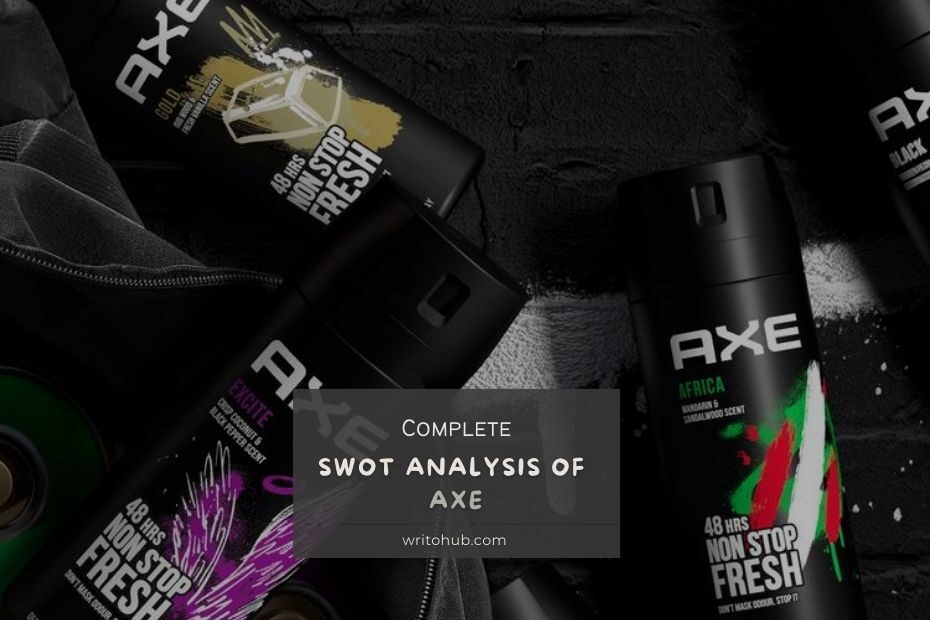Axe, a well-known brand under Unilever, specializes in men’s grooming and personal care products.
A SWOT analysis of Axe reveals its strengths, weaknesses, opportunities, and threats, offering insights into its strategic position in the dynamic personal care market.
Strengths in the SWOT Analysis of Axe
- Strong Brand Identity: Axe has built a strong and recognizable brand image that resonates with its target audience of young men.
- Product Range: The brand offers a wide range of grooming products, including deodorants, body washes, and hair care, catering to the diverse grooming needs of men.
- Effective Marketing: Axe’s innovative and often humorous advertising campaigns have been successful in creating brand awareness and connecting with consumers.
- Global Presence: The brand has a global footprint, providing access to a wide range of markets and demographics.
- Frequent Product Innovation: Axe consistently introduces new products and fragrances, staying competitive and relevant in the personal care industry.
Weaknesses in the SWOT Analysis of Axe
- Narrow Target Audience: Axe’s focus on a young male demographic can limit market expansion and diversification.
- Competition: The personal care industry is highly competitive, with numerous brands vying for market share, impacting pricing and product differentiation.
- Environmental Concerns: The beauty and personal care industry faces scrutiny regarding its environmental impact, including issues related to packaging and product ingredients, which can affect Axe’s image.
- Online Retail Challenges: The rise of e-commerce and changing consumer shopping habits require a robust online presence and digital marketing to stay competitive.
- Price Sensitivity: While Axe products are generally affordable, price-conscious consumers may still seek lower-cost alternatives.
Opportunities in the SWOT Analysis of Axe
- Sustainability Initiatives: Strengthening sustainability efforts in packaging, sourcing, and product development can align with evolving consumer preferences for eco-friendly products.
- Market Diversification: Exploring opportunities in adjacent markets, such as personal care products for women or specialized grooming needs, can diversify Axe’s product portfolio.
- Digital Transformation: Leveraging e-commerce and digital marketing strategies can enhance customer engagement, accessibility, and market reach.
- Global Expansion: Expanding into emerging markets with rising male grooming needs offers significant growth potential.
- Customization: Offering personalized grooming solutions and fragrances can enhance customer satisfaction and brand loyalty.
Threats in the SWOT Analysis of Axe
- Economic Downturns: Economic recessions and reduced consumer spending can impact the demand for non-essential personal care products, affecting sales.
- Counterfeit Products: The cosmetics and personal care industry faces ongoing issues related to counterfeit or imitation products, which can harm brand reputation and consumer safety.
- Supply Chain Disruptions: Ongoing supply chain disruptions, geopolitical tensions, and trade disputes can affect production and product availability.
- Regulatory Changes: Evolving regulations related to cosmetics ingredients, safety standards, and environmental practices can impact product development and compliance costs.
- Changing Consumer Preferences: Shifts in consumer grooming habits and preferences can impact product demand and market competition.
Conclusion
Axe’s SWOT analysis highlights its position as a recognized brand in the men’s grooming and personal care market.
To maintain and enhance its market presence, Axe must leverage its strengths, address weaknesses, seize opportunities, and mitigate threats while adapting to changing consumer preferences, environmental considerations, and competitive dynamics in the personal care industry.
